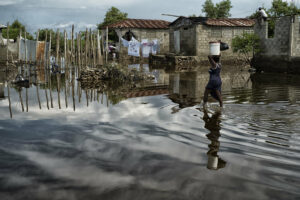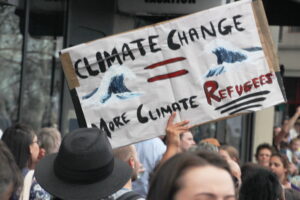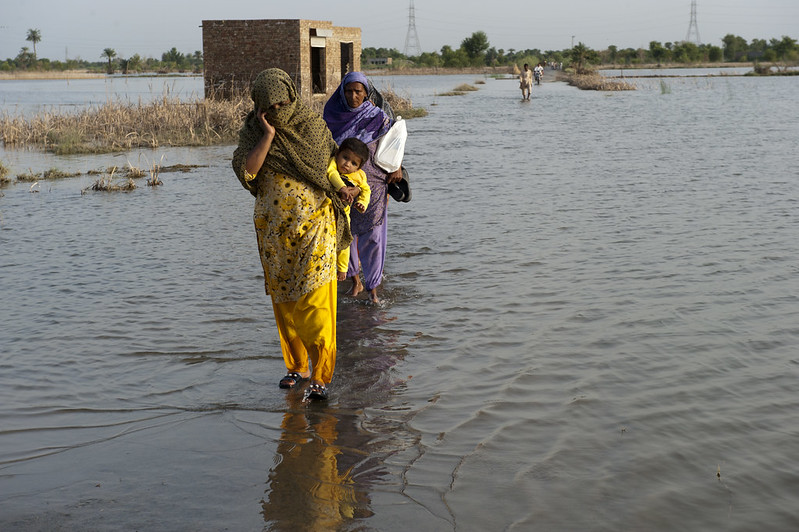All over the world, from Mexico to Pakistan to right here in the United States, millions of people in the coming decades will be forced to leave their homes as their communities become uninhabitable.
Why? Because of climate change.
Up to 200 million people will be displaced by 2050 due to climate impacts, such as:
- Sea level rise
- Salt water inundation
- Drought
- Storms
- Decreased crop productivity
And this is nothing new. 7 million people were internally displaced by extreme weather events in the first half of 2019 alone. This number is nearly double the number of people displaced by conflict and violence during the same period in 2019. And it’s only going to get worse. A total of 23 million people moved due to climate- or weather-related disasters last year.

Flickr: United Nations Photo
Who’s In Danger?
Climate migrants will often be people of color, low income, and come from rural areas in developing nations. These groups of people are least likely to have the adaptive capacity to withstand climate change.
Rural communities in the Global South, in particular, rely heavily on subsistence agriculture or fishing. As their livelihoods are threatened, they will be forced to move towards urban areas.
Migrants, Not Refugees

Flickr: United Nations Photo
You may have heard the term “climate refugees” in discussions about displacement due to climate change. While the term climate refugee is widely accepted by the media, climate migrants are not legally considered refugees by international refugee law.
The 1951 Refugee Convention defines a refugee as someone “who is unable or unwilling to return to their country of origin owing to a well-founded fear of being persecuted for reasons of race, religion, nationality, membership of a particular social group, or political opinion.” This definition does not include the millions of people forced to flee due to climate change or weather-related disasters.
Because climate migrants are not legally considered refugees, they have very few legal protections. While some countries have broadened their own definition of a refugee, very little headway has been made through international agreements in expanding the definition of refugees to include climate migrants. This leaves it up to individual countries to provide their own pathways for climate migrants.
Planning For Climate Migrants
Mohamed Nasheed, former president of Maldives, famously said, “You can drastically reduce your greenhouse gas emissions so that the seas do not rise so much, or when we show up on your shores in our boats, you can let us in. Or when we show up on your shores in our boats, you can shoot us. You pick.”
If history has taught us anything, it’s that countries don’t like refugees. Well, that might not be fair. Developed countries don’t like refugees of color.
For example, thousands of Syrian refugees who fled civil war in 2015 perished on unsafe, overpacked vessels. Those who survived were not welcomed with open arms due to anti-immigration policies. On the other hand, recent refugees from the war in Ukraine have been received into neighboring countries positively.
With the majority of climate migrants being people of color, this asks the question, “What are we going to do to ensure these climate migrants are taken care of?”
One solution? Michael Gerrard has proposed that developed countries accept a number of climate migrants proportional to their country’s contributions to climate change. After all, shouldn’t those who contributed the most to climate change take responsibility for those impacted by climate change?
Real People, Real Stories
Climate migrants themselves have consistently been left out of the debate about how to address climate migration in the coming decades, and it’s important to give them a seat at the table in decision making process. I encourage you to read, listen, learn, and share climate migrant stories. Below are some testimonies of those displaced by climate change.
“Rains recently have been very intense… Years ago the rainy season lasted two months, November and December, and water levels reached 20 to 30 Centimeters. Now, in the last six to seven months, they’ve reached over two meters… We don’t want to leave our land: here are our past, our memories, our ancestors. We don’t want to move to other parts, we don’t know what to do there.” – Octavio Rodriguez, Sucre, Colombia.
“Climate change has wrecked everything; our people are living in other towns and cities, like refugees. All I wanted was to grow old with my children and their children. But now they are gone and I don’t think they will ever return.” – Shamisur Gazi, Chakbara, Bangladesh
“The snow and ice are disappearing and melting day by day, year by year… There might be no more snow, no more water coming down. So how would we irrigate our plots of land? My son would have to leave and go somewhere else, to other countries.” – Lucia Quispe, Khapi, Bolivia
3 Ways to Advocate for Climate Migrants

Flickr: John Englart
Relocating 200 million displaced people is no small task and this issue won’t be solved overnight, but here are some things we all can do:
- Write our representatives and ask them to include climate migrants in the United States’s definition of refugees.
- Advocate for climate mitigation, not just adaptation, to prevent further displacement.
- Seek out and amplify climate migrant stories in order to lift up the voices of those most impacted that often go unheard.
Feature Image Obtained From Flickr: Asian Development Bank

